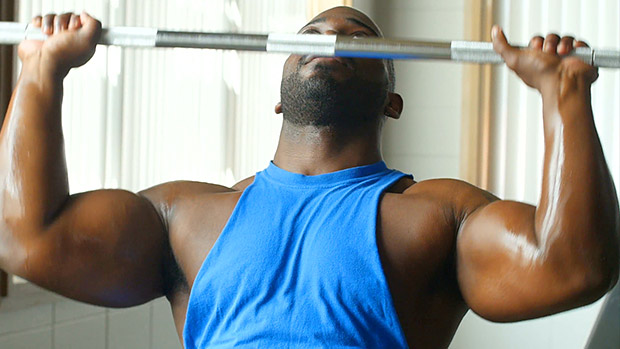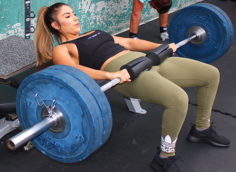Lead Photo Credit: Brad Neathery
Already a T Nation+ Member? Log in
You haven’t completed your membership signup
Your T Nation+ membership has expired
Get instant access to this content
Become a T Nation+ member and get immediate access to all of our member-only videos, articles, coaching groups and more.
Click here to learn more about T Nation+Click here to complete the signup processClick here to renew your membership
What's the Best Training Program?
Is it the workout plan used by the biggest and leanest pro bodybuilder? The strongest lifter with the most powerlifting records? Probably not. Their programs work for their (often drugged) bodies, not necessarily your (probably natural) body.
Instead of getting lost searching for the perfect program, you need to adopt a set of strategies and methods that have been proven to work for everyone. You can then take this template of strategies and customize it by choosing the best exercises for your body and your goals.
First, let's review the strategies:
Natural lifters often make two common mistakes. First, they try to specialize in building muscle too early. They never really build a base of strength to support more advanced, bodybuilding-style training.
Second, they change exercises too often. This can even lead to program hopping: jumping from one plan to the next before they've even given the first plan a chance to work. This is a monkey-mind mentality.
Increasing your workout or movement frequency – lifting 4-5 days a week – is a foundational strategy for building both strength and mass. Here's what it'll do for you:
Increase your motor learning
Motor learning is basically familiarizing yourself with a particular exercise until that movement becomes natural.
It's simple really. The more often you perform a movement, the more familiar your muscle memory becomes in performing that movement.
Better motor learning will yield better long-term progress because you'll be able to move more weight, improve muscle fiber recruitment, and create more mechanical tension directly in your muscles.
Increase your protein synthesis
The more often you train a muscle the more protein synthesis you'll trigger. Protein synthesis is the fundamental biological process by which cells build their specific proteins – and your muscles grow through this process.
High movement frequency is the key that unlocks the protein synthesis process for days on end. Studies have shown that protein synthesis responds to resistance training and lasts about 24-48 hours afterward.
That's one of the main reasons why training a muscle group frequently (verses once a week or so on "chest day") is a crucial aspect of making strength and size gains – because it keeps protein synthesis at its peak. The more often you train the muscle the more consistent protein synthesis will be.
Also, protein synthesis keeps you in an anabolic (muscle building) state and keeps your testosterone levels elevated. As a result, you can expect to make consistent gains in size and strength.
The smallest changes to your technique can be the key to busting through training plateaus. Here's why:
Micro-adjustments reduce injuries
You can't make regular gains if you're always tweaking your shoulder or pulling a muscle. And that's where the smallest adjustments can make the biggest difference – keeping you away from the injuries.
By making small changes in bar position, foot placement, or grip, you can create enough variation to prevent overuse injuries (and boredom), without completely altering your workout. This works with just about every exercise.
Here's an example of a micro-adjustment: Your lower back is acting up when you squat. Instead of hurting yourself or tossing the squat out of your workout, make a small adjustment to where you position the bar on your back. Go from high-bar to low-bar squats to take some stress off your lower back and even decrease the range of motion in the movement.
Micro-adjustments drive progress
Sustainable systems are the key to gains. So when you hit a small bump in the road with your training, whether it's an injury or simply feeling less motivated, don't upend the entire system. A pothole on Gains Street doesn't require ripping up the entire program. Just repair the pothole. Stay consistent. Push yourself and make small adjustments when necessary.

Your goal when you walk into the gym is simple: get stronger. If getting stronger isn't your goal, you'll miss out on muscle gains as well as the obvious strength gains. Every muscle building and fat-burning technique is limited if you don't start with a great strength base.
Think of it like this: The person who trains to "build muscle" will do okay for himself and make modest gains for a while. But the person who trains to "get stronger first, then build muscle second" will make better gains and KEEP making them.
Once you build your base of strength then other conditions, like improving your mind-muscle connection, become increasingly important. But with all other factors being equal, the stronger guy is going to be bigger. So increase the weight on the bar, even if it means lowering the amount of reps you do.
Now, if you're going to build the most strength and size, you need to put an emphasis on the movements that initiate the greatest anabolic response. These include: the squat, deadlift, lunge, carry, bench press, bent-over row, weighted pull-up, weighted dip, and overhead press.
Without these exercises in the mix, you simply won't make the most progress in the shortest amount of time, or the most sustainable progress over a long period of time. A 300-pound bench press is going to do a heck of a lot more for your strength and physique than a 30-pound bicep curl. If you want gains, you need to use compound movements.
Now, compound movements won't have their fullest effect on your physique unless you put an amount of weight on the bar that has you hovering around the 4 to 8 rep range (or even 1 to 8 rep range if you've got a spotter with you).
For example, deadlifting 225 pounds for 5 reps will only carry your physique so far. If you don't gradually progress to 245 pounds and then 275 pounds and so on, your strength and physique will hit a plateau. Bottom line: Challenge yourself with heavier loads often.
After you've increased your strength base you can add some size-focused rep ranges and specialized hypertrophy exercises.
Reps for size
To maximize muscle growth you need to leverage classic bodybuilding rep schemes. The sweet spot for reps is 8-12. That's heavy enough to create significant tension in the muscle, yet light enough to allow multiple reps and metabolic stress – another key component of muscle growth.
Another effective strategy is high-rep sets of 12-20 or more reps. Though this has been called a "muscular endurance" rep range, these high-rep sets can create one hell of a muscle-building challenge, especially with isolation exercises and challenge-based finishers.
Techniques for size
These are isolation exercises, but now that you've build your strength base you can perform them with weights not covered in pink vinyl.
Pre-Set Holds
Just pause at the hardest point, or mid-rep, and hold the weight there for 15-30 seconds. This works great with a barbell curl. If you find yourself struggling to hold the weight for this long at the beginning of the exercise, decrease the weight. After holding, go immediately into 8-12 reps without resting. Pre-set holds will improve your mind-muscle connection and accelerate muscle growth.
Failure Training
This is a great way to get a good pump and build muscle on the heels of your strength training. In fact, one recent study found that when you perform an exercise to failure with loads of 30% of your 1 rep max (very light, 20+ reps) it's nearly as effective as using loads of 80% of your 1 rep max. So when you train isolated muscle groups, do the exercise until you can't do it any longer. You'll get the pump of your life.
Just to give you an idea of what this can look like, here's a sample program for the intermediate lifter.
- You'll hit each major muscle group 2-3 times per week with a variety of strength and muscle-building rep ranges.
- Monday and Thursday are a push-focused. You'll train triceps, quads, chest, and anterior delts as a primary focus on each day.
- Tuesday and Friday are pull days. You'll train biceps, lats, traps, glutes, and hamstrings.
- Saturday is a bonus accessory or "vanity" day designed to hit any lagging body parts that didn't get the love they needed during the week.
Remember, as long as you follow the guidelines above you can change this up however you need to in order to keep the gains coming.
Monday: Push
| Exercise | Sets | Reps | rest | |
|---|---|---|---|---|
| A1 | Box Jump | 2 | 5 | 30 sec. |
| A2 | RKC Plank | 2 | 20 sec. | 30 sec. |
| B | High-Bar Back Squat | 4 | 4-6 | 2 min. |
| C | Dumbbell Bench Press | 5 | 8 | 60-90 sec. |
| D1 | Dumbbell Walking Lunge | 3 | 10/leg | 60 sec. |
| D2 | Seated Dumbbell Press | 3 | 10 | 60 sec. |
| E | Cable Chest Flye | 4 | 15 | 30 sec. |
| Do an isometric hold at full contraction for 15 seconds at reps 5 and 15. | ||||
| F | Triceps Cable Pushdown | 4 | 30 | 30 sec. |
Tuesday: Pull
| Exercise | Sets | Reps | rest | |
|---|---|---|---|---|
| A | Deadlift (any variation) | 4 | 4-6 | 3-5 min. |
| B | Chin-Up | 4 | 6-8 | 2 min. |
| C | Single-Arm Dumbbell Row | 3 | 15-20 | 90 sec. |
| D | Single-Leg Hamstring Curl | 4 | 8 | 30 sec. |
| Do an isometric hold at mid-rep for 15 seconds at reps 4 and 8. | ||||
| E | Barbell Biceps Curl | 4 | 6 | 90 sec. |
| F1 | Dumbbell Upright Row | 3 | 9 | |
| F2 | Dumbbell Shrug (3 sec. pause at the top) | 3 | 8 | |
| F3 | Dumbbell Farmer's Walk | 3 | 50 steps | 60 sec. |
Thursday: Push
| Exercise | Sets | Reps | rest | |
|---|---|---|---|---|
| A | Barbell Bench Press | 4 | 4-6 | 2 min. |
| B | Hack Squat | 4 | 8 | 60 sec. |
| C1 | Bulgarian Split Squat | 3 | 12/10/8 | 45 sec. |
| C2 | Single-Arm Dumbbell Press | 3 | 12/10/8 | 45 sec. |
| D | Dip | 4 | 12 | 60 sec. |
| E | Leg Extension | 4 | 12 | 45 sec. |
| Do an isometric hold at full contraction for 15 seconds at reps 3 and 12. | ||||
| F1 | Feet Elevated Push-Up | 3 | failure | |
| F2 | Standard Push-Up | 3 | failure | |
| F3 | Hands-Elevated Push-Up | 3 | failure | 90 sec. |
Friday: Pull
| Exercise | Sets | Reps | rest | |
|---|---|---|---|---|
| A | Barbell Bent Over Row | 4 | 4-6 | 3-5 min. |
| B | Pull-Up/Lat Pulldown | 4 | 6-8 | 2 min. |
| C | Dumbbell Romanian Deadlift | 5 | 10 | 90 sec. |
| D | Chest Supported Row | 4 | 12 | 45-60 sec. |
| E1 | One-and-a-Half Rep Inverted Row | 3 | 20 | 30 sec. |
| Do a full row, lower yourself halfway down, then up again. This is one rep. | ||||
| E2 | Kettlebell Swing | 3 | 20 | 30 sec. |
| F1 | Ab Wheel Rollout | 3 | 8 | |
| F2 | Sicilian Crunch | 3 | 10 | |
| F3 | Stability Ball Crunch | 3 | 20 | 45 sec. |
Saturday: Vanity
| Exercise | Sets | Reps | rest | |
|---|---|---|---|---|
| A1 | Dip | 4 | 6-8 | 90 sec. |
| A2 | Alternating Dumbbell Biceps Curl | 4 | 6-8 | 90 sec. |
| B1 | Dumbbell Lean Away Lateral Raise | 4 | 4-10 | |
| B2 | Dumbbell Arnold Press | 4 | 4-10 | 60 sec. |
| C1 | Dumbbell Hammer Curl | 3 | 12 | 45 sec. |
| C2 | Dumbbell Skull Crusher | 3 | 12 | 45 sec. |
| D1 | Standing Calf Raise (Pause at the top.) | 3 | 12 | 45 sec. |
| D2 | Seated Calf Raise (Pause at the top.) | 3 | 20 | 45 sec. |





